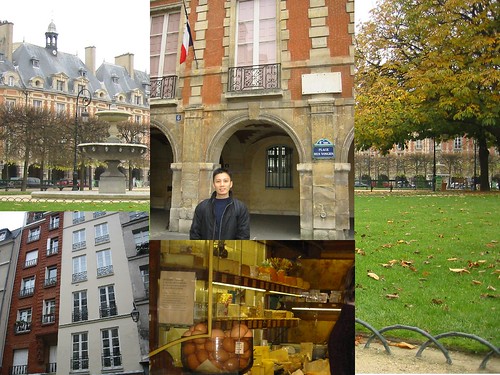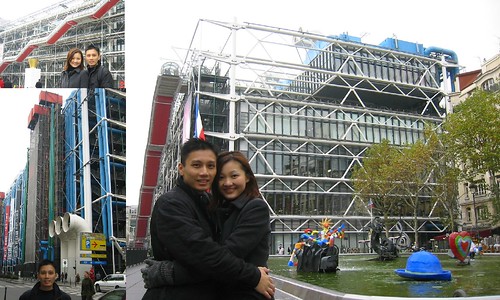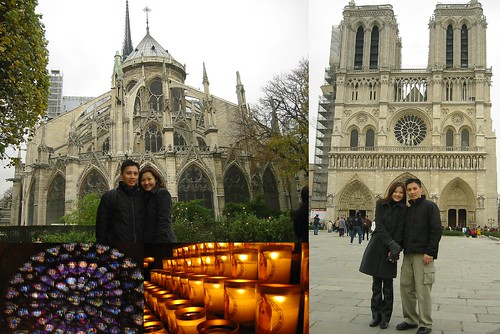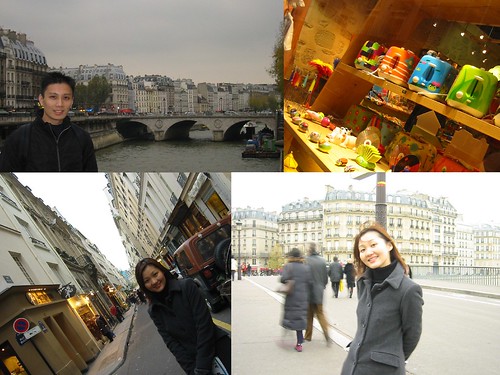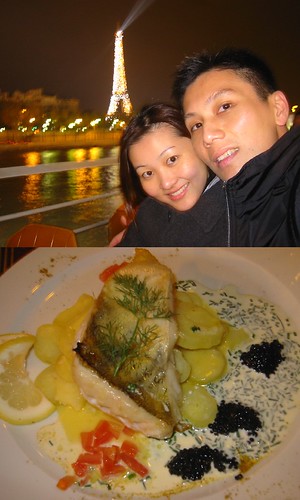PARIS Day04//11.Nov.04 - In Love & War: The Marais + Beaubourg & Les Halles + Ile de la Cité + Ile St. Louis
France observes November 11th - Armistice Day, as a public holiday where recognition is given to fallen World War soldiers. Like the French, we took today slightly easier after yesterday's hectic schedule. There were no more museums or monuments to visit. So, instead of waiting patiently behind ticket queues, our feet traversed the lovely neighbourhoods of the 3rd and 4th arrondissement.We started our fourth day at Le Marais which is located in the 3rd arrondissement. For such a lovely neighbourhood, it's ironic that the name "Marais" is derived from the word "marsh", which hardly conjures images of quaint streets, charming squares or aristocratic town houses. However, due to the neighbourhood's proximity to the Seine River, it makes geological, and etymological sense according to the definition by Cambridge:
marsh [noun] ground near a lake, river or the sea, that tends to flood and is always wet:At the mouth of the river is a large area of marsh.Historically, Marais was mired* in decades of decay before it effervesce** into a lively neighbourhood that's full of character. Marais has over the years gain a reputation of being Paris' gay neighbourhood and Jewish quarter. This marriage of orthodox and avant garde lifestyles seems to coexist peacefully as S and I made our way through le Marais. It was here where I saw Parisians walking around with baguettes*** bought fresh from the boulangerie (bakery). I don't know why, but I found such delight in witnessing that stereotype brought to life.
S and I walked towards the Place des Vosges^, where, aside from being one of Paris' oldest squares, it was also where Victor Hugo once lived and wrote most of Les Miserables. Victor Hugo's house was marked with France's tri-coloured flag and is located in a corner of the square. Centred in the square was yet another garden. Less formal, but providing a nice contrast to the stately and symmetrical buildings that surround it. As S and I crossed the garden, we watched with amusement at parents minding their enfants who were running around the garden with unreserved juvenile joy.
Our less limber footsteps eventually brought us to Beaubourg and Les Halles area. Whereas, Marais was quieter and dated, Beaubourg and Les Halles was without doubt, rowdier and crowded. Admist all that, the Pompidou Centre stood out easily with its unique architecture. Pipes of blue (air-cond ducts), green (water pipes), yellow (electricity lines), red (escalators), and white (ventilation shafts) delineated this box-y looking building of modern art. Despite the public holiday, the Musee National d'Art Moderne within was opened to the public and did not lack visitors whom were noticeable through the see-through escalator shafts.
Having been unable to appreciate contemporary/modern art in my previous experience at Barcelona, we gave the Pompidou Centre a miss and were content to just taking photos of the building and the bizarre looking fountains at Place Igor Stravinsky. From surrealistic 1980s fountains we passed the last Renaissance fountain in Paris - Fontaine des Innocents, as we walked down the crowded main streets of Beabourg. Along the way, we brought our lunch from a crepe/kebab food stand next to the busy street. By the time we've reached the end of the street and arrived at Forum des Halles, I've already finished munching on my crepe au compote pomme (apple compote crepe). Forum des Halles had a somewhat futuristic look with its underground levels and palm-shaped buildings. Inside, it contains present day shops although S and I did encounter our first remotely controlled public toilettes! Here, in order to access the toilets, the toilet custodian must first be paid before he points the remote at the elevator-like entrance and voila! Open sesame! We did not want to spend too much time at Les Halles as the areas surrounding it was rather seedy-looking with shops of questionable character. Hence, we took the conveniently located Metro within Forum des Halles to a more quintessentially Parisian area of Ile de la Cité.
Being a tiny island, there is only one Metro stop in Ile de la Cité. Nevertheless, as the cradle of Parisian civilization, the size of the island did not constrain the religious and political architectures that dominated our views on that Thursday afternoon. It was particularly cold that day, with our hands firmly clasped, we huddled passed the Palais de Justice and Sainte-Chapelle^^. Both buildings are noted for different reasons. Palais de Justice for its towers and immense breadth that stretches the entire width of Ile de la Cité; Sainte-Chapelle for its magnificent stained-glass windows, resplendent when the sun shines bright, which on this day it did not. Based on the 3 star rating from Frommers, I had originally planned to enter the cathedral, however with the lack of sunshine and the long queue snaking into the entrance, we agreed to give this cathedral a miss.
What couldn't be missed however was the Notre-Dame. As the embodiment of Gothic architecture, it proudly displays its flying buttresses, gargoyles and spiring towers. Notre-Dame was a hive of activity that day as a special mass was held in conjuction with Armistic Day. On this rare occassion, we saw flags from various nations lending colour within the gloomy interior of Notre-Dame. Normally, the only other source of bright colours would have been from the stained-glass 'rose' windows. While on our way out, S took a photo of the colourful 13m South Rose Window.
With every step towards Ile St. Louis, the tolling of Notre-Dame's bells faded into the distant. The island of Ile St. Louis is smaller and linked to Ile de la Cité by Pont St. Louis. Crossing Pont St. Louis, we were afforded with picturesque views of elegant 17th century residences. These mansions of iron-wroughted balconies were once inhabited by lords and financiers, now however, you will more likely to find the nouveau riche****. S and I spent a blissful late afternoon walking round this stately neighbourhood and having our romantic stroll by the banks of the Seine river. We spent some quiet minutes resting on a bench by Seine river before continuing with the guidebook's suggested route. Our walk brought us to Ile St. Louis' main street i.e. Rue St. Louis. Here, we came across numerous quaint and quirky shops, French provincial restaurants and the famous Berthillon ice-cream flagship shop. We have been recommended by a friend to try Paris' best ice-cream, but being such a cold day, we decided to save it for our next trip.
Having spent the entire day covering the 3rd and 4th arrondissement, we decided to head back to our hotel for some rest before our Seine river cruise that night. Our rest was much needed as it had helped recharged us enough to run towards the dock near Pont de l'Alma before our barge departs at 9pm. We had a choice between the uncovered upper deck or the covered lower deck. As the upper deck afforded a better view, we decided to brave the cold night air. It was a one-hour slow cruise pass Paris' famous landmarks, and loops around the two islands of Ile de la Cité and Ile St. Louis. With all the buildings and monuments beautifully illuminated, the chilly winds and frozen ears were well worth it. By the end of the cruise, the cold has helped fuel our hunger and we propelled towards a restaurant in Marais that was recommended by a friend. Thankfully, it didn't take too long for us to locate Le Coude Fou and to get a table. The restaurant had a laidback and cosy setting. So near was our neighbour that he offered to help us out with the French-only menu. Our dinner companion turns out to be a fascinating Dutch personality who was once a plastic surgeon with a penchant for antiques and had moved to France for his retirement. S and I were thankful for his acquired French because the duck S chose and the fish I had were simply delicious. Warmed by good food, French red wine, and pleasant company, we made our way back to the hotel that night without much ado.
* 1 : wet spongy earth (as of a bog or marsh); 2 : heavy often deep mud or slush 3 : a troublesome or intractable situation
** 1 : to bubble, hiss, and foam as gas escapes; 2 : to show liveliness or exhilaration - Merriam-Webster
*** baguette: Is French for a "rod," "wand," or "stick." Baguette is the name for anything long and skinny, including drum sticks, strips of wood, etc. The baguette is generally known as a French white bread due to its popularity in that country. Baguettes are formed into a long, narrow, cylindrical loaf. It usually has a thin, crisp brown crust and a open-holed, chewy interior. History - The shape for which it is famous was developed by an Austrian baker and brought to France in the middle of the nineteenth century. At first French bread was all shaped round, but when bakers realized that their crusts were so tasty, they gave the bread more crust by making them long. - emenus.ca/Victoria_and_Vancouver_Island/dictionary/B.htm
****Etymology: French, literally, new rich - Merriam-Webster
^ Its history goes back to 1604 when King Henri IV built a Royal pavilion at the southern end of the square. The King ordered all 35 other buildings bordering the square to follow the same design. The result, an early example of urban planning, is a symmetrical square surrounded by buildings with red brick and white stone facades, steep slate roofs and dorm windows, all constructed over arcades. -
^^ Countless writers have called this tiny chapel a jewel box. Yet that hardly suffices. Nor will it do to call it "a light show." Go when the sun is shining and you'll need no one else's words to describe the remarkable effects of natural light on Sainte-Chapelle. Begun in 1246, the bi-level chapel was built to house relics of the True Cross, including the Crown of Thorns acquired by St. Louis (the Crusader king, Louis IX) from the emperor of Constantinople. - Frommer's
